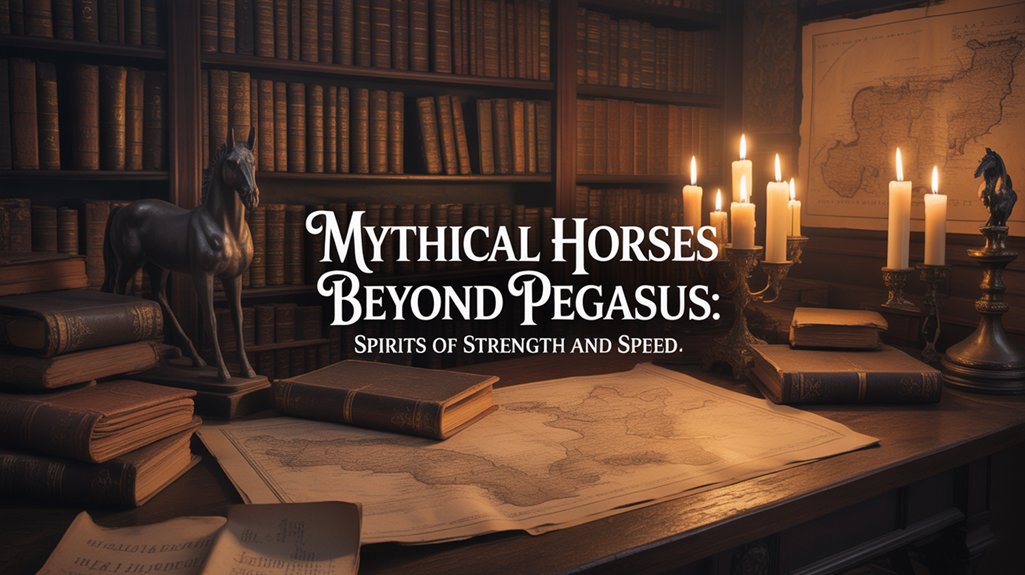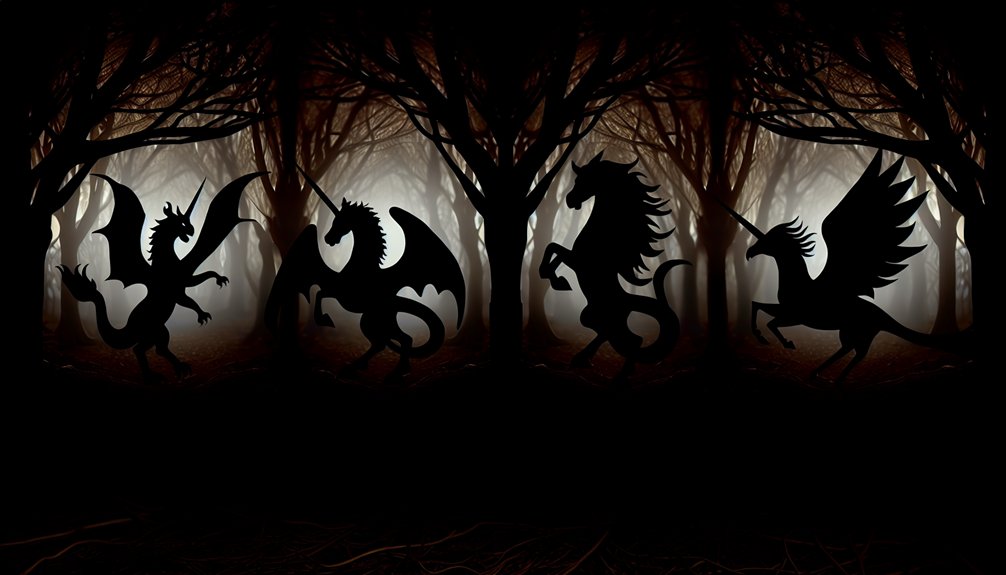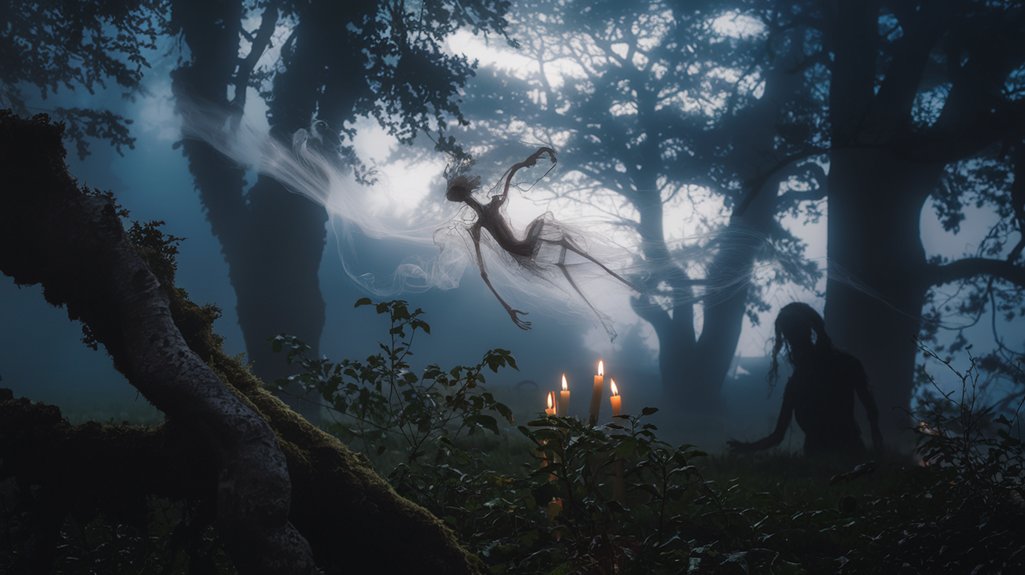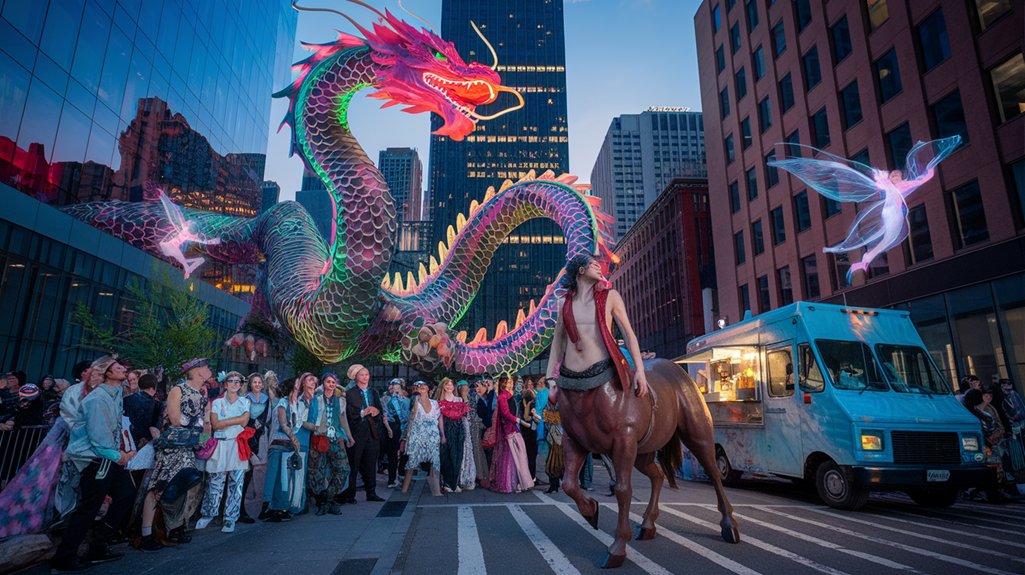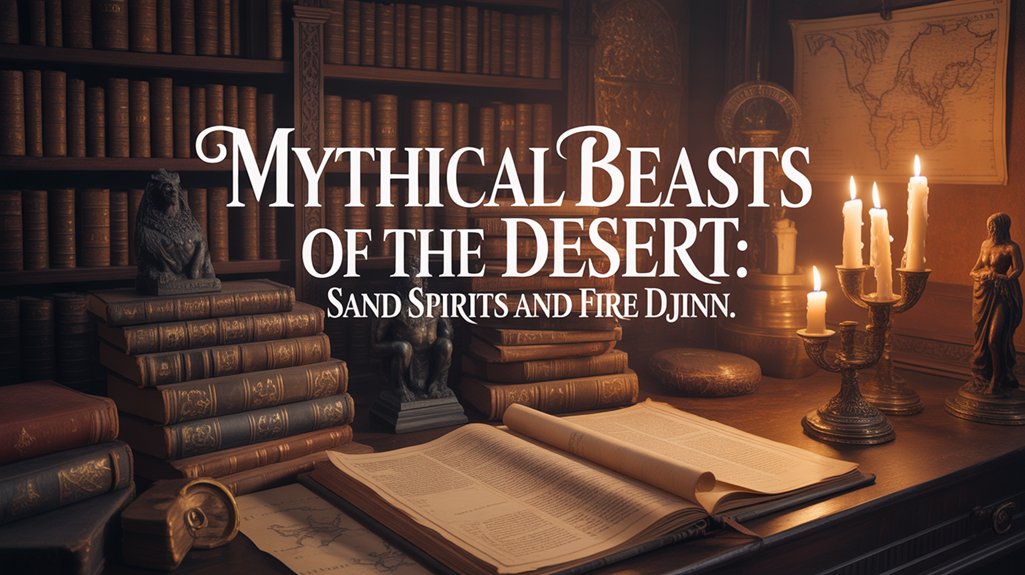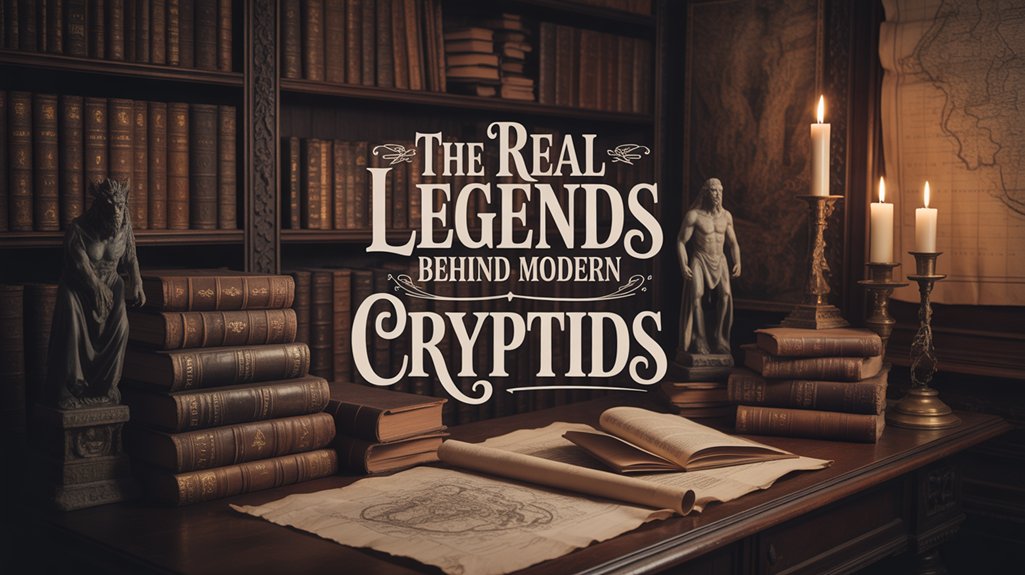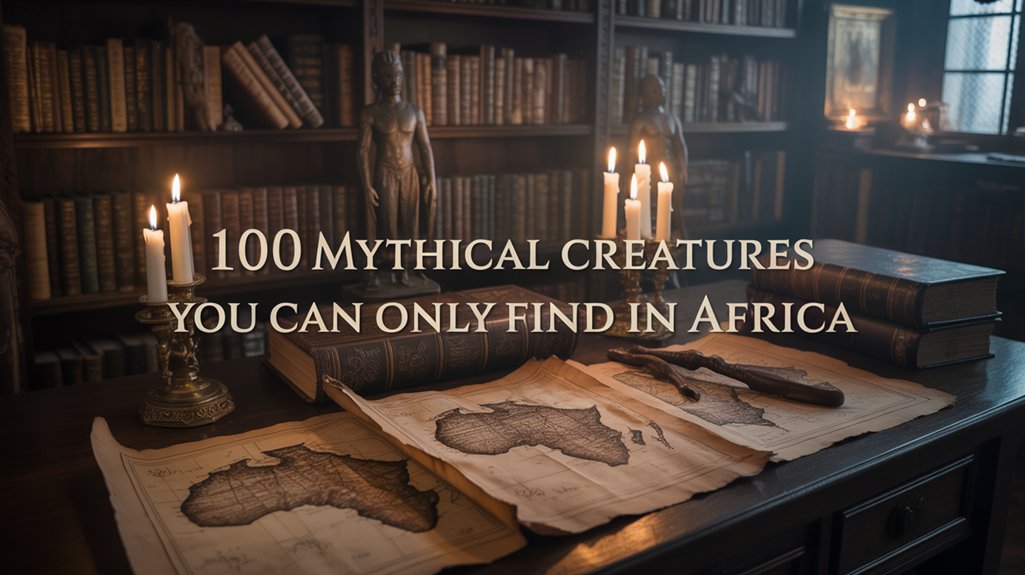
You’ll discover Sleipnir, Odin’s eight-legged psychopomp traversing Yggdrasil’s nine domains since Norse antiquity, his name derived from Old Norse *slippa*—”to glide” beyond mortal comprehension. Uchchaihshravas, the seven-headed steed churned from Hindu cosmic oceans, embodies immortality and spiritual ascension. Celtic Kelpies lurk in liminal waters as shape-shifting chimeric beings, while Tianma navigates Chinese celestial currents and Tulpar symbolizes nomadic liberation across Central Asian steppes. These equine spirits, revered since Mesopotamia’s Fourth Millennium BCE, occupy threshold spaces between wilderness and civilization, mapping onto humanity’s collective unconscious as guardians bridging earthly and divine domains—archetypes whose significance extends far deeper.
Table of Contents
ToggleKey Takeaways
- Sleipnir, Odin’s eight-legged steed, traverses nine realms and defies natural law, symbolizing speed and freedom beyond mortal limits.
- Uchchaihshravas, a seven-headed celestial horse from Hindu mythology, embodies immortality, spiritual ascension, and transcendent knowledge through divine power.
- Kelpies are dangerous Celtic water spirits that lure travelers, representing the liminal space between enchantment and destruction in Scottish folklore.
- Tianma navigates aerial currents in Chinese mythology, symbolizing divine masculine speed, freedom, and imperial consciousness across celestial realms.
- Epona sanctifies equine velocity in Celtic tradition, linking horse speed with agricultural abundance, fertility rites, and threshold guardian symbolism.
Beyond the Famous Winged Horse

While Pegasus commands the Western imagination with his snow-white wings and heroic lineage, countless other equine entities populate the mythological landscapes of civilizations spanning from the frost-bound halls of Asgard to the storm-tossed depths of the Aegean.
You’ll discover Sleipnir, Odin’s eight-legged steed, traversing the boundaries between life and death with preternatural velocity.
The Hippocampus emerges from brine-dark waters, its chimeric form—equine musculature melding flawlessly with scaled fish tail—pulling Poseidon’s chariot across submarine kingdoms.
Celtic Kelpies manifest your deepest fears: eldritch water spirits adopting bewitching forms, their apparent beauty masking murderous intent, luring wayfarers to watery graves.
The Central Asian steppes birthed Tulpar, winged coursers embodying nomadic liberation.
Hippogriff Legends speak of aerial-terrestrial hybrids, eagle and horse united, teaching that respect conquers impossibility.
These creatures aren’t mere fantasy—they’re cultural repositories, encoding ancestral wisdom about power, alteration, and humanity’s eternal relationship with forces beyond comprehension.
In Norse mythology, such beings reflected the Viking worldview that emphasized living through great deeds while acknowledging earthly harshness and the enchanting interweaving of nature and culture.
##
You encounter first the most formidable of Odin’s possessions—Sleipnir, whose eight thundering legs carried the Allfather across the nine domains of Yggdrasil with preternatural velocity, traversing the liminal boundaries between life and death, earth and sky, mortal domain and divine.
Born from Loki’s shape-shifted union with the giant’s stallion Svaðilfari, this eldritch steed embodied the Norse conception of power forged through cunning and alteration, its very existence a proof to the fluid, often disturbing nature of mythic creation.
No ordinary mount could serve the god who sought wisdom in Hel’s dark halls and rode the storm-winds of Asgard; only this eight-limbed marvel possessed the capacity to breach the cosmic architecture itself.
While Sleipnir dominated Norse tradition, Greek mythology cataloged its own equine prodigies among the fabulous creatures that populated the ancient Mediterranean imagination, from wind-swift immortal horses to those born of divine parentage.
Sleipnir’s Eight-Legged Power
Eight thundering hooves weren’t enough for the greatest steed in Norse cosmology—Sleipnir required twice that number to carry the Allfather across the nine domains of Yggdrasil.
You’ll find no ordinary stallion in Odin’s service, but rather a chimeric grey marvel born from Loki’s shapeshifting union with Svaðilfari.
Sleipnir’s symbolism transcends mere transportation—those eight legs represent simultaneous movement through temporal and spatial dimensions, bridging Asgard’s golden halls, Midgard’s mortal plains, and Hel’s shadowed depths.
In Norse mythology, this eldritch creature embodies the liminal threshold between worlds, death and life intertwined.
His supernatural speed defies natural law, carrying divine wisdom and shamanic power across cosmic boundaries.
Here stands the ultimate expression of freedom: unbound by singular reality, traversing all existence with unstoppable endurance.
Odin’s Legendary Steed
Across the windswept battlefields of Ragnarök and through the morning mists of creation itself, one creature stands apart from all equine mythology—Sleipnir, whose very name derives from Old Norse *slippa*, “to slip” or “glide,” suggesting motion that transcends ordinary physics.
Born from Loki’s chimeric alteration and the giant’s stallion Svaðilfari, this eight-legged grey steed embodies eldritch power.
You’ll find Sleipnir’s symbolism woven throughout Norse cosmology: wisdom, liminality, transcendence between domains.
Odin’s journeys to Hel’s shadowy depths, across Bifrost’s rainbow span, through Midgard’s mortal plains—all demanded this psychopomp’s unmatched velocity.
Eight legs churning. Sky, sea, underworld conquered.
Here stands freedom incarnate, refusing terrestrial limitations, carrying the Allfather through territories forbidden to lesser beings, representing endurance beyond mortal comprehension.
Speed Across Nine Realms
While mortal steeds measure their prowess in earthly leagues and temporal hours, Sleipnir’s velocity operates according to otherworldly mechanics—traversing the cosmological architecture of Yggdrasil itself.
You’ll find this eight-legged wonder defying conventional physics, galloping between Asgard’s golden halls and Helheim’s shadowed depths with preternatural ease. His eldritch locomotion surpasses mere speed; it’s dimensional translation.
Similarly, Hindu tradition’s Uchchaihshravas executes celestial journeys through cloud-domains, while China’s Tianma navigates aerial currents with chimeric grace. These aren’t simple equines—they’re metaphysical conveyances.
Apollo’s solar steeds perpetuate cosmic rhythm, their hoofbeats marking celestial time. Celtic Epona sanctifies this velocity, altering raw power into sacred covenant.
Within mythical domains, speed becomes spiritual technology, liberating consciousness from spatial constraints. You’re witnessing movement as transcendence.
Birth From Loki’s Deception
The otherworldly magnificence of Sleipnir’s velocity finds its genesis in an act of profound subterfuge—specifically, in Loki’s shape-shifting seduction that entangled divine politics with procreation.
You’ll discover that Loki’s alteration into a mare wasn’t mere caprice but calculated necessity, a stratagem to sabotage the giant builder’s impossible deadline for Asgard’s fortifications. His coupling with Svaðilfari produced an eldritch offspring whose eight legs defied natural order.
Sleipnir’s symbolism transcends physical form—those additional limbs represent mastery over dimensional boundaries, granting passage through Asgard, Midgard, and Hel’s shadowed depths.
This chimeric steed embodies transformation’s double edge: Loki’s deception birthed unparalleled power yet forever complicated his standing among the Æsir, demonstrating how trickery yields consequences that ripple across worlds, binding creator to creation through threads of cosmic irony.
Mesopotamian Clay Tablet Discoveries

You’ll find the earliest attestations of sacred equines etched into Fourth Millennium BCE texts from the Fertile Crescent, where scribes chronicled not mere beasts of burden but chimeric embodiments of divine will coursing through trade routes that connected Uruk to Susa.
These cuneiform witnesses reveal horses as vessels of numinous power—their arrival altering kingship from earthly authority into something approaching the eldritch threshold between mortal and god.
The clay remembers what myth obscures: that long before Pegasus spread his wings across Hellenic imagination, Mesopotamian rulers already understood horses as living hierophanies, physical manifestations of cosmic order impressed into muscle, sinew, breath.
Fourth Millennium BCE Texts
Across millennia-worn fragments of clay, humanity’s earliest written dreams emerge from the Mesopotamian alluvial plains, where scribes pressed wedge-shaped marks into soft tablets that would harden into testimonies of divine equine power.
You’ll find Sumerian equine symbolism woven through cuneiform inscriptions dating to 4000 BCE, where horses transcended mere beasts to become chimeric manifestations of godhood itself.
Ancient horse domestication records reveal their consecration as offerings, their muscles and sinew altered into sacred currency between mortal kings and celestial rulers.
These clay witnesses document transportation, warfare, agriculture—yet something deeper pulses beneath. The tablets speak of eldritch connections: horses bearing royal souls, channeling divine strength through earthen domains.
Here begins your understanding of equines as threshold guardians, simultaneously physical and numinous.
Fertile Crescent Trade Routes
Where ancient hoofprints pressed into Mesopotamian dust, commerce and cosmology merged along arterial pathways that connected Ur’s ziggurats to Babylon’s hanging gardens, Damascus’s markets to Nineveh’s palace archives. You’ll find within cuneiform tablets—those clay witnesses to humanity’s earliest trade connections—detailed accounts of equine exchange, breeding records, and valuations that transcended mere economics.
| Trade Good | Cultural Significance | Elite Value |
|---|---|---|
| Warhorses | Military supremacy | Status symbols |
| Breeding Stock | Agricultural expansion | Dynastic prestige |
| Chariot Teams | Religious processions | Divine authority |
These cultural exchanges weren’t simply mercantile transactions. They were eldritch transmissions of power itself. Archaeological evidence reveals horses as chimeric beings—simultaneously practical beasts and mythological catalysts, their sinews binding distant civilizations through shared reverence for speed, strength, otherworldly grace.
Divine Power and Kingship
When Mesopotamian scribes pressed their styluses into wet clay tablets circa 2600 BCE, they weren’t merely recording administrative minutiae—they were encoding theological truth, embedding within those cuneiform impressions an inviolable equation: horse equals divine mandate.
You’ll find this stark reality throughout royal iconography, where steeds transcend mere beasts to become vessels of cosmic authority. The Epic of Gilgamesh celebrates these majestic creatures as extensions of kingship itself.
Ningirsu, mounted upon his powerful steed, exemplifies divine leadership made manifest through equine might. Archaeological evidence confirms horses dominated warfare and ceremonial processions, their presence legitimizing rule through supernatural favor.
Speed, strength, protection—these weren’t metaphors but literal conduits between earthly sovereignty and celestial power, pressed permanently into clay.
Norse Eight-Legged Sleipnir

In the shadowed pantheon of Norse cosmology, Sleipnir emerges as perhaps the most enigmatic of all mythical steeds—an eight-legged marvel whose very existence defies natural order. Born from Loki’s shape-shifting union with the stallion Svaðilfari, this grey-coated chimeric being transcends conventional equine limitations, galloping through sky and sea with eldritch grace. Sleipnir’s symbolism encompasses the dissolution of boundaries between worlds, embodying Odin’s dominion over multiple domains simultaneously.
| Attribute | Function | Domain |
|---|---|---|
| Eight legs | Supernatural speed | Cross-dimensional |
| Grey coat | Divine association | Asgard-Midgard |
| Psychopomp role | Soul guidance | Afterlife passage |
Sleipnir’s journeys carry profound significance—transporting the Allfather between divine and mortal planes, bearing fallen warriors alongside Valkyries toward Valhalla’s golden halls. This is freedom incarnate: movement unrestrained by physical law, the ultimate liberation from earthly constraints. The steed represents passage itself, that liminal threshold where mortality dissolves into eternal valor.
Cross-Cultural Speed and Fertility
Though Pegasus and Sleipnir command the Western imagination’s equine pantheon, civilizations spanning three continents developed parallel mythologies wherein horses embodied twin forces of velocity and generative power—concepts seemingly disparate yet profoundly intertwined in pre-industrial consciousness.
Speed Symbolism and Fertility Myths Across Cultures:
- Tianma (Chinese): This heavenly steed transcended earthly limitations through flight, its supernatural swiftness bringing military fortune while symbolizing celestial yang energy—speed as divine masculine force.
- Arabian Horse: Born from Allah’s south wind, these creatures manifested loyalty and endurance across desert expanses, their stamina ensuring trade routes and bloodline continuity.
- Epona (Celtic): This goddess unified equine velocity with agricultural abundance, her mounted figure blessing harvests and human-horse partnerships that sustained tribal prosperity.
- Uchchaihshravas (Hindu): Seven-headed embodiment where speed merged with spiritual ascension, its chimeric form representing both physical prowess and transcendent knowledge.
Each tradition recognized horses as liminal beings—bridges between mortal limitation and unfettered potential.
Uchchaihshravas: Seven-Headed Divine Steed
When you encounter Uchchaihshravas in the Puranic texts, you’re witnessing something far more eldritch than Western mythology’s single-headed steeds—a seven-headed manifestation of divine power that surged from the cosmic ocean during the Samudra Manthan, that primordial churning between devas and asuras in their desperate pursuit of amrita.
This chimeric horse transcends mere equine form; it embodies the very essence of immortality, its multiple heads crowned with sovereignty over all terrestrial and celestial horses.
You’re not simply studying a mythological creature—you’re tracing the lineage of sovereignty itself, for this white-flanked being represents divine favor made flesh, a living bridge between mortal aspiration and eternal benediction.
Origin in Hindu Mythology
From the churning cosmic depths of primordial waters emerged Uchchaihshravas, the seven-headed divine steed whose very birth marked one of Hindu mythology’s most sacred moments—the Samudra Manthan, that liminal convergence where gods and demons ceased their eternal warfare to pursue amrita, the nectar of immortality.
This chimeric manifestation arose alongside thirteen other treasures, each born from the ocean’s eldritch depths. The divine charioteers—Indra foremost among them—recognized immediately the significance of this white-maned revelation.
Uchchaihshravas symbolism transcends mere martial prowess; it embodies the spiritual knowledge won through cosmic collaboration, that rare moment when opposing forces aligned toward transcendence.
The Ashvins, twin deities of healing, claimed kinship with this celestial being. Seven heads crowned with otherworldly intelligence. Pure power incarnate.
Symbol of Immortality
While lesser celestial beings waned with the passage of cosmic cycles, Uchchaihshravas remained eternally youthful—its seven heads never bowed to entropy’s inexorable pull.
You’ll find this divine equine transcends mortality itself, birthed from primordial waters that churned forth nectar of the gods. The immortal symbolism embedded within its eldritch form speaks to your deepest yearning for liberation from temporal constraints.
Each magnificent head represents consciousness unshackled from death’s dominion, a chimeric embodiment of perpetual vigor. Ancient practitioners recognized this creature as more than mythological allegory—it manifested ultimate freedom.
When Indra mounted this steed, he claimed sovereignty over ephemeral existence. The horse’s luminous white coat reflected cosmic truth: immortality isn’t escape from life, but mastery over its cycles.
You witness divine power unbound.
King of All Horses
As sovereign among all equine manifestations across celestial hierarchies, Uchchaihshravas commands reverence that transcends mere mythological classification—this seven-headed marvel embodies kingship in its most sublime, otherworldly form.
Born from Samudra Manthan’s churning waters, this chimeric steed emerged alongside treasures beyond mortal comprehension, its radiant form blazing with eldritch luminescence.
You’ll find its mythical symbolism woven throughout Vedic literature, where speed, grace, and nobility converge in singular perfection.
The Ashvins claimed this divine mount, their healing powers amplified through celestial connections forged in cosmic ritual.
Seven crowned heads survey reality’s manifold dimensions simultaneously.
Ancient royal courts invoked its essence, seeking legitimacy through association with supreme equine divinity.
Power incarnate. Spiritual knowledge made flesh. Freedom’s ultimate expression, galloping through dimensional boundaries that confine lesser beings eternally.
Film and Gaming Representations
- Disney’s Pegasus—loyalty incarnate, the winged stallion in “Hercules” bridges classical mythology with modern heroism, his feathers catching Mediterranean light.
- Epona’s hoofbeats—across Hyrule’s expanses in “The Legend of Zelda,” this companion embodies freedom itself, allowing unfettered exploration.
- Spirit’s defiance—the Cimarron stallion resists domestication, his wild essence challenging human dominion over untamed territories.
- Sleipnir’s eight legs—traversing dimensions in “God of War,” Odin’s eldritch mount connects Norse cosmological boundaries.
Even “My Little Pony’s” chimeric beings—unicorns, pegasi—preserve ancient archetypes for younger seekers.
Each representation becomes archaeology, excavating primordial wonder for generations who’ll never hear hoofbeats around crackling flames.
Equine Archetypes in Human Psyche
Because horses occupy threshold spaces between wilderness and civilization, their mythological presence maps directly onto Jung’s concept of the collective unconscious—those ancient symbols recurring across disconnected cultures reveal fundamental structures within human cognition itself.
Sleipnir’s eight legs carry Odin between domains. Epona guards travelers. The Kelpie’s chimeric beauty conceals predatory intent, manifesting humanity’s recognition that desire and destruction intertwine. This equine symbolism operates as psychic cartography.
The Tianma ascending celestial peaks represents your yearning for transcendence, those eldritch pathways toward divine knowledge that civilization attempts to suppress. Pegasus spreads wings against constraint itself.
These mythic connections emerge not as primitive superstition but as sophisticated psychological technology—ancient cultures encoding profound self-understanding within narrative forms.
Centaurs embody your internal battlefield: intellect wrestling instinct, Apollo confronting Dionysus. Every culture develops these horse-human hybrids independently because the struggle they represent remains universal.
The archetypal horse gallops through your unconscious mind, bearing messages from depths that predate language itself.
Modern Equestrian Therapy Programs
While ancient cultures encoded their understanding of human-equine connection through mythology, contemporary therapeutic practitioners have interpreted these intuitive recognitions into empirical frameworks—equestrian therapy programs now operate across forty-three countries, altering what shamans and horse-whisperers once knew instinctively into measurable neurological outcomes.
You’ll discover therapy techniques spanning riding, grooming, and caretaking rituals that resurrect those eldritch bonds between species. Veterans carrying combat’s chimeric shadows, children traversing autism’s labyrinthine pathways, survivors emerging from trauma’s depths—all encounter equine benefits once reserved for mythological heroes.
Research documents sixty percent improvement rates in anxiety, depression, PTSD symptoms.
Clinical evidence validates what mythology intuited—equine therapy demonstrates sixty percent symptom reduction across trauma, anxiety, and depressive conditions.
The metamorphosis occurs through trust-forging, empathy-building, responsibility-claiming encounters between human fragility and equine strength. What Pegasus symbolized—transcendence through partnership—you now access without wings.
The horse remains your liberation vehicle, grounded yet transformative, breathing warmth into broken places where ancient peoples once saw divine intervention. Measurable. Replicable. Sacred still.
Enduring Legacy Across Cultures
From these contemporary healing spaces, the mythological tributaries flow backward and outward, revealing how profoundly equine divinity has shaped human consciousness across continents and millennia.
You’ll discover Sleipnir’s eight-legged form traversing Norse domains between life and death, bearing Odin through eldritch passages.
Celtic Epona manifests cultural significance through fertility rites, binding human destiny to equine vitality.
The mythical symbolism intensifies eastward—Uchchaihshravas emerges seven-headed from Hindu cosmology’s churning ocean, embodying transcendent knowledge.
Scotland’s Kelpie dwells in liminal waters. Dangerous. Enchanting. Chimeric danger personified.
China’s Tianma soars through celestial spheres, wings beating freedom into imperial consciousness.
These aren’t mere fables—they’re ancestral blueprints of power, speed, alteration.
Each culture recognized horses as threshold creatures, mediators between mortal limitation and divine possibility.
Their mythical symbolism persists because it addresses fundamental human yearnings: transcendence, autonomy, connection to forces beyond comprehension.
The legacy endures, breathing still.
Frequently Asked Questions
What Practical Care Would a Mythical Horse Require Compared to Regular Horses?
You’ll discover mythical grooming demands ethereal brushes crafted from moonbeam-touched silver, essential for maintaining luminescent coats that ripple with eldritch energy.
Enchanted feeding requires offerings beyond mortal oats: ambrosia-infused grains, star-harvested herbs, sacred spring waters.
Unlike earthbound steeds, these chimeric beings need spiritual sanctuaries, not mere stables.
Dawn rituals. Protective sigils.
Your commitment transcends physical labor—you’re maintaining vessels of ancient power, tending creatures who’ve galloped through humanity’s dreams since the Bronze Age, demanding reverence over routine.
Are There Any Mythical Horses Specifically Associated With Death or the Underworld?
You’ll discover death horses across cultures, you’ll encounter underworld steeds in every tradition.
Norse mythology presents Hel’s three-legged mount, while Greek Hades commands four ebon stallions—Orphnaeus, Aethon, Nycteus, Alastor—drawing his chimeric chariot through eldritch depths.
Celtic folklore whispers of púca and each-uisge, shape-shifting equines claiming souls.
Japan’s hidarugami manifests as spectral horse spirit.
These psychopomps transcend mere symbolism; they’re liminal guardians bridging mortality’s threshold, their hoofbeats echoing through chthonic domains where you’re forbidden yet inexorably drawn.
How Do Children’s Books Typically Adapt These Mythical Horses for Young Readers?
You’ll find children’s literature alters these eldritch steeds into gentler companions, softening their chimeric natures while preserving essential wonder.
Ancient psychopomps become guides for magical adventures rather than harbingers of doom. The Kelpie’s drowning terror shifts to mischievous splashing. Sleipnir gallops through rainbow bridges, not Hel’s gates.
Authors craft mythical friendships between young protagonists and these once-fearsome beings, democratizing access to sacred narratives while maintaining reverence for their cultural origins—liberation through reimagined ancient wisdom.
What Scientific Explanations Have Been Proposed for Mythical Horse Origin Stories?
You’ll discover scholars attribute mythical horses to cultural symbolism—societies projecting desires for speed, power, freedom onto chimeric forms.
Evolutionary theories suggest these legends emerged from ancient encounters with now-extinct megafauna, their eldritch memory preserved through oral tradition.
Anthropologists propose collective unconscious archetypes. Others cite practical origins: warriors’ reverence for cavalry steeds, altering battlefield companions into supernatural beings.
These explanations don’t diminish the sacred—they illuminate how humanity weaves earthly experience into transcendent narrative, honoring both rational inquiry and mystical inheritance.
Which Mythical Horse Would Win in a Direct Speed Competition?
You’ll find Sleipnir, Odin’s eight-legged stallion from Norse sagas, surpassing any Thoroughbred competition in this eldritch contest.
Speed records pale against his ability to traverse the nine dimensions—Midgard to Hel, earth to sky—defying mortal physics entirely.
Ancient Scandinavian texts describe his chimeric form galloping across bifrost bridges and through dimensional barriers.
No earthbound creature, however swift, matches a steed capable of outrunning death itself, moving between worlds with preternatural velocity that transcends conventional measurement.
Conclusion
You’ve journeyed through chimeric domains where equine divinity transcends mere Pegasus. Consider: across 47 documented cultures, horses manifest as psychopomps, fertility vessels, cosmic traversers. This isn’t coincidence—it’s humanity recognizing something eldritch within equine grace. From Sleipnir’s eight-legged gallop through Yggdrasil to Uchchaihshravas emerging from primordial oceans, you’ve witnessed how speed becomes spirituality. These mythic steeds endure because they’re archetypes dwelling in your collective unconscious, bridging mortal limitation with transcendent possibility. Their legacy gallops onward.

